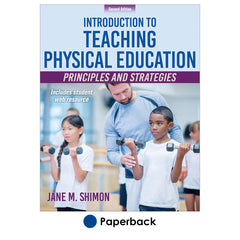Writing Performance Objectives for a Lesson Plan
This is an excerpt from Introduction to Teaching Physical Education 2nd Edition With Web Resource by Jane M Shimon.
Performance objectives are clear and specific statements of what students will be able to do by the end of a lesson (Gronlund and Brookhart 2009; Mager 1997). For example, an objective found in a basketball lesson might include something like this: Students will be able to dribble up and down the court without losing control of the ball. Or: When working cooperatively in groups, students will be able to develop two ways to get open to receive a pass.
Performance objectives need to be observable, measurable, and attainable. The preceding performance objective examples are observable: The teacher and students can observe if they are dribbling a basketball under control while looking up or if they are working together in groups to solve a problem during a lesson. These performance objectives are also written so that you can determine whether students have achieved them—that is, you can assess how many students look up while dribbling under control or determine who is able to work cooperatively with their teammates. Finally, these performance objectives are realistic and attainable for students during a lesson.
Sometimes performance objectives are written in ways that are not observable or measurable. Objectives that use words such as learn or understand or comprehend cannot be observed or measured. They are ineffective, and those words do not clarify the learning or performance outcome (see table 8.1). An incorrect performance objective might read something like this: Students will learn how to dribble a basketball, or students will understand how to get open to receive a pass.

When writing a performance objective for a lesson plan, include (1) the task, (2) the condition, and (3) the criteria.
- Task (what): The main part of a performance objective involves a task or behavior. In other words, what do you want students to be able to do? Do you want students to be able to dribble a basketball under control, execute a forward roll, work cooperatively in groups, or describe how to perform a skill or create a fitness and conditioning program? These examples describe various tasks students will be able to accomplish during the lesson.
- Condition (how): The condition of a performance objective describes a circumstance or situation of performing the task. In other words, how will students do the task? How will they be able to demonstrate what they know or can do? For example, how do you want students to dribble a ball under control? Do you want them to dribble a ball in their own space, by following a line along the floor, up and down the court, between cones, or against a defender? Do you want them to dribble the ball while walking or running? Describing the condition of a performance objective makes the task specific.
- Criteria (how well): Finally, a performance objective includes some type of standard or level of performance that informs you and your students about the quality of the performance to accomplish. In other words, how well do you want students to perform the task? Do you want students to perform the task in a certain amount of time, perform a skill correctly, or complete a certain number of successful attempts (e.g., 8 out of 10)? Do you want students to cooperatively work together in groups, or pass a written test at 80 percent accuracy? Including criteria provides a way to measure or assess the performance objective (Rink 2014).
Some physical education teachers write performance objectives with a broader focus by including only the task and condition components; others add criteria to make the objective more precise. Your instructor will specify the type of performance objectives you will be required to write for your lesson plans.
Performance objectives can be written for each learning domain, depending on the learning outcomes of the lesson. Because outcomes for a lesson may involve more than one domain, teachers often include several performance objectives within a lesson. For example, you may want your students to be able to dribble a basketball around cones without losing control (psychomotor domain) and describe various ways to get open to receive a pass (cognitive domain).
One last factor to consider when developing performance objectives involves the verb choice you select as part of your objective. The verb used in an objective informs a certain level of action to accomplish and will infer a level of complexity and specificity within a domain of learning. As mentioned in chapter 2, Bloom's taxonomy refers to three domains of educational outcomes (cognitive, affective, and psychomotor), and the levels within each domain go from simple outcomes to the most complex (Anderson 2013; Anderson, Krathwohl, and Bloom 2001). Categories found under the psychomotor domain are recognized levels for that domain (Dave 1970). Table 8.2 illustrates verbs to consider for each domain level.

While most educators are familiar with Bloom's taxonomy, you may be required to classify your level of learning outcomes using a different classification system, depending on the accreditation requirements at your school. The Webb's Depth of Knowledge model (Webb 2002) modifies Bloom's taxonomy by combining the levels into four categories (table 8.3). Whatever system you use, remember that the verb used in the performance objective reflects a level of learning, the scope and sequence of your lesson plan, and the learning outcome for your students.

Overall, performance objectives provide direction and purpose as you develop your lesson plans. Performance objectives inform students about what they will be learning or expected to do and accomplish during the lesson, and performance objectives can be assessed, which informs you and your students if lesson objectives have been met (Buck et al. 2007; Rink 2014).


Get the latest insights with regular newsletters, plus periodic product information and special insider offers.
JOIN NOW


